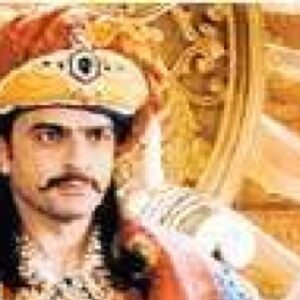In the 12th century, Prithviraj Chauhan was a Rajput king who governed the kingdoms of Ajmer and Delhi in northern India; he was one of the last independent Hindu kings to rule Delhi. He was a Rajput ruler from the Chauhan dynasty who was also known as Rai Pithora. Prithviraj began demonstrating evidence of his brilliance at a young age, as the son of Someshwar Chauhan, the ruler of Ajmer. He was a bold and brilliant boy with exceptional military abilities. He could hit targets accurately even as a small child based solely on their noises. Prithviraj Chauhan succeeded to the throne when his father was killed in a battle in 1179. He ruled over the twin capitals of Ajmer and Delhi, which he inherited from his maternal grandfather, Tomara dynasty’s Arkpal or Anangpal III. He went on multiple campaigns to expand his territory as king, and he earned a reputation as a fierce and daring warrior. His wars with Shahabuddin Muhammad Ghori, as well as his elopement with Sanyukta, the daughter of Raja Jaichand of Kannauj, are well-known.
Childhood and Adolescence
Someshwar Chauhan, the ruler of Ajmer, and Karpuri Devi gave birth to Prithviraj Chauhan in 1149.
He grew up to be a bright, daring, and fearless young man. His maternal grandfather, Arkpal or Anangpal III of the Tomara dynasty, was so impressed that he named him as his heir.
Reign & Ascension
In 1179, Someshwar Chauhan perished in a battle and was succeeded by Prithviraj, who reigned from the twin capitals of Ajmer and Delhi. After assuming the throne, he embarked on a series of campaigns to expand his realm.
His first campaigns were against Rajasthan’s minor states, which he easily subdued. Then he led an invasion against the Khajuraho and Mahoba Chandelas. He was able to beat the Chandelas and gain huge booty as a result of this campaign.
In 1182, he launched an invasion on Gujarat’s Chaulakyas. The conflict raged for years until he was vanquished in 1187 by Chaulakya monarch Bhima II.
In addition, he conducted a military war against the Kannauj Gahadvalas for control of Delhi and the upper Ganga doab. Although he was able to extend and protect his territory as a result of these conflicts, he also became politically isolated from his neighbors.
In 1191, Shahabuddin Muhammad Ghori invaded the castle of Bhatinda in East Punjab, which was on Prithiviraj Chauhan’s border. Chauhan requested assistance from Kannauj, but was turned down. Undaunted, he marched to Bhatinda and met his foe at Tarain, where they engaged in a great combat. The First Battle of Tarain was named after this event.
The battle was won by Prithiviraj, who captured Muhammad Ghori. Ghori begged for mercy, and Prithviraj, being the benevolent king that he was, decided to let him go. Several of his ministers objected to Prithviraj’s decision to offer mercy to the enemy, but Ghori was politely freed.
The choice to release Ghori proved to be a major blunder, as Ghori quickly reassembled his army in preparation for another conflict. In 1192, Ghori returned with a force of 120,000 soldiers to confront Chauhan in what became known as the Second Battle of Tarain. Prithviraj’s army included 3,000 elephants, 300,000 horsemen, and a large infantry force.
Ghori was well aware that Hindu warriors only fought from daybreak to dusk. So he divided his army into five groups and struck in the wee hours of the morning, when the Rajput army was preparing for fight. The Rajput army was eventually crushed, and Ghori kidnapped Prithviraj Chauhan.
Battles of Importance
In the Battles of Tarain, Prithviraj Chauhan led the Rajput army against the Ghurid force led by Shahabuddin Muhammad Ghori in 1191 and 1192. He defeated his opponent in the first battle and afterwards released him. Chauhan was beaten in the second fight and captured as a result.
Personal History and Legacy
Sanyukta (also known as Sanyogita, Sanjukta, or Samyukta), the daughter of Raja Jaichand of Kannauj, was Prithviraj Chauhan’s first love. Her father was against the match because Prithviraj was from a rival clan. So, with the exception of Prithviraj, he organized a “Swayamvara” for his daughter, to which he invited all of the eligible monarchs and princes. He commissioned a clay statue of Prithviraj to be positioned as the doorman to further insult him. When Prithviraj and Sanyukta learned about this, they developed a scheme to deceive her father.
To her father’s displeasure, the bride-to-be snubbed all the suitors present on the day of the “Swayamvara” and garlanded the clay figure. Then Prithviraj, who had been lurking behind the statue, emerged, eloped with Sanyukta, and took her to Delhi. Govindraj, Akshay, and Rensi were among the children born to the couple.
Muhammad Ghori captured and executed Prithviraj Chauhan during the Second Battle of Tarain. Maharani Sanyukta and other Rajput women committed suicide rather than surrender to the Afghan invaders after their husbands were kidnapped by Muhammad Ghori.
According to legend, Prithviraj Chauhan murdered Ghori with the assistance of his companion Chand Bardai. Prithviraj Chauhan was blinded with red hot irons after being apprehended. Prithviraj Chauhan’s renowned ability to hit a target only based on sound came in handy, and he is thought to have slain Muhammad Ghori with “shabdabhedi baan.” After slaying Ghori Prithviraj, Prithviraj and Chand Bardai killed each other to avoid being slain by enemies. However, there is no historical evidence to back up this allegation.
Estimated Net Worth
The estimated net worth of Prithviraj Chauhan is unknown.


